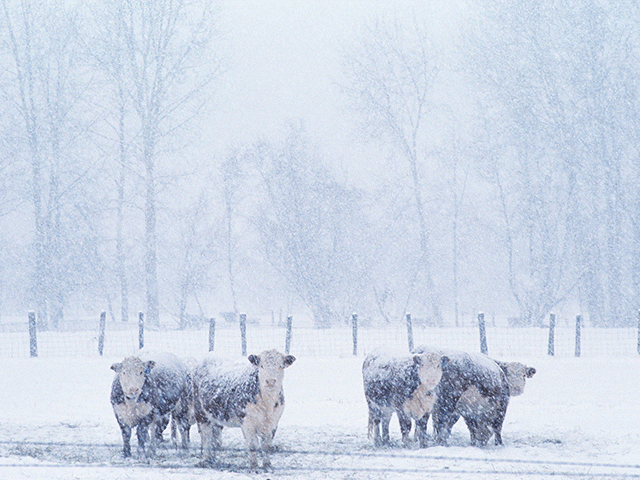Windbreaks Protect Livestock in Winter
Different Windbreaks Designs Protect Livestock, Lower Feed Costs
OMAHA (DTN) -- Mike Berdo's cows were cold.
In the days before Christmas, the Washington, Iowa, cattle producer had fed some additional feed to his cows grazing on stalks. Because it was so cold, the cows retreated to a low-lying area protected by trees as they attempted to stay warm. They would not leave this area.
"We had to move the bunks to them," Berdo told DTN.
In addition, part of his fat-cattle feeding area is protected by a wooden and metal windbreak structure. This solid wall keeps the wind and snow off the cattle.
Often the difference between life and death for livestock in extreme winter conditions is finding these areas to protect animals. Cattle will need more feed to keep warm without the aid of windbreaks, according to research.
WINDBREAK CONSTRUCTION
Windbreak designs are as endless and original as the livestock producers who construct and use these structures. They can be built with metal, wood or even other components such as grain bin metal/flooring and highway guardrails.
Berdo constructed his windbreak using metal square tubing, two-by-six wood and roofing metal. The structure is a solid wall design about 10 feet tall. It keeps the winter wind and snow off his feedlot cattle or from even getting to them in their lot. As it redirects the wind and snow, the structure will have some snowdrifts around it.
"It serves its purpose," Berdo said.
P[L1] D[0x0] M[300x250] OOP[F] ADUNIT[] T[]
DIFFERENT DESIGNS
Different windbreak designs have been studied, according to a University of Nebraska-Lincoln (UNL) report titled "Windbreaks for Protection and Snow Diversion by Brad Schick, UNL Extension Educator (https://beef.unl.edu/…).
Porous and solid (non-porous) windbreaks were studied. A solid windbreak built into a "V" shape will create protection from snow and in the crux of the "V".
The sides of the "V" should form a 90-degree angle and the point should be built facing into the prevailing winds, according to the report. This will cause snow to be diverted around the ends of the barrier and form drifts away from the sheltered area.
"Shelter in this design is considered reducing wind speed by 60% with minimal snow accumulation," the UNL report said.
The shelter width (measured as the distance between the open ends of the windbreak) should not exceed 15 times the height of the windbreak. For example, a barrier 8 feet tall can have sides no longer than 85 feet because the distance between the ends of the sides with the configuration is 120 feet wide.
Porous windbreaks can be constructed in a line and can be either permanent or temporary. This type of windbreak's effectiveness is determined by the open area as a percentage of the total, which affects the amount of wind reduction.
Research has shown that porosity at 25% to 33% will optimize protection from wind and snowdrifts. The protected area will be eight to 10 times the height of the windbreak. A 10-foot-tall fence with 25% to 33% porosity will provide 80 to 100 feet of protection behind it.
If vertical boards are used to build the windbreak, 6-inch boards will need a 2-inch space to create 25% porosity.
SAVE FEED
An article titled "Guidelines for Livestock Windbreaks" by South Dakota State University Extension Specialist Kiernan Brandt told producers they should try and mitigate the effects of cold weather on cattle (https://extension.sdstate.edu/…). When the temperature drops below 30 degrees Fahrenheit, energy requirements increase approximately 13% for every 10 degrees decrease in windchill.
In addition, cattle can experience cold stress below 18 F, even if they have the thickest winter coats, according to the report.
Brandt stressed it's important to understand that windbreaks do not eliminate wind -- they just simply redirect the wind. In many cases, wind velocity may increase as it is redirected around a windbreak.
Whether the windbreaks are permanent or temporary, they must be sturdy enough to withstand high winds, said Brandt. Posts for permanent structures should be at least 8 feet thick and extend into the ground 3 to 5 feet below the frost line.
For mobile structures, a base of at least 1.5 times the height is necessary and should be constructed with heavy materials to prevent them from tipping over in high winds or cattle rubbing on them.
Brandt noted windbreaks should be positioned perpendicular to the wind direction. V-shaped windbreaks should be used in areas with multiple wind directions. Deviations of up to 30 degrees in windbreak angle still provide adequate protection.
Russ Quinn can be reached at Russ.Quinn@dtn.com
Follow him on Twitter @RussQuinnDTN
(c) Copyright 2023 DTN, LLC. All rights reserved.






